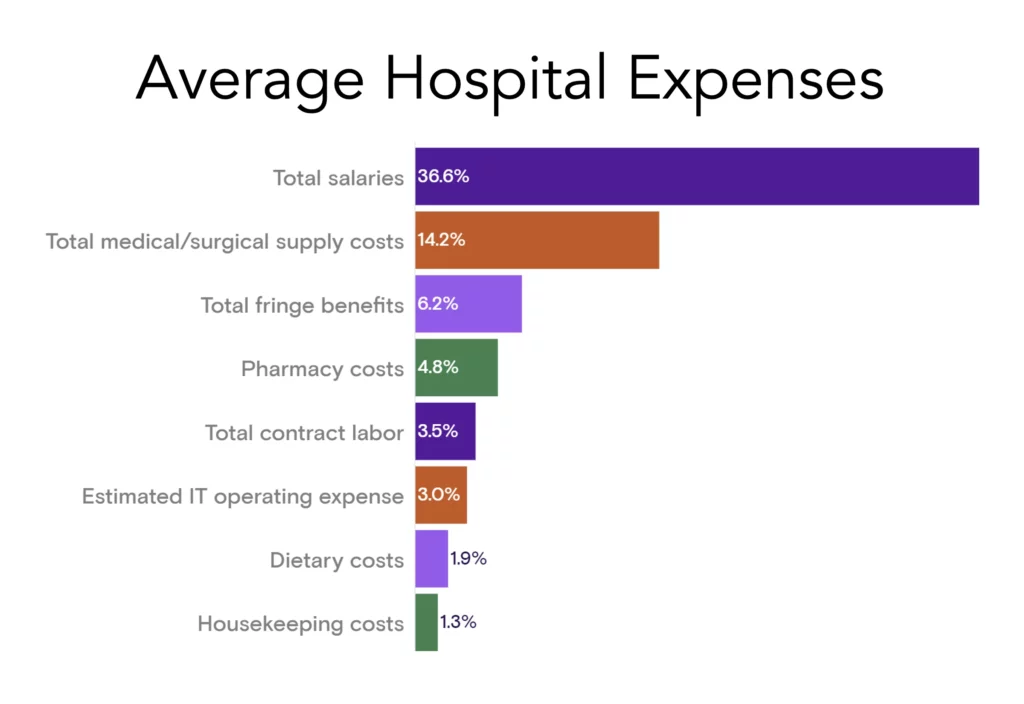Hospitals continue feeling the financial pinch. For many, costs are up. Revenues are down.
This is not a problem limited to a few hospitals in a few parts of the country. By the end of 2022, over half of U.S. hospitals faced a financial operating loss. In 2023 and 2024, financial pressures have continued to grow. While most hospitals point to declining reimbursement rates, nursing and physician shortages, and preventable medical errors, another expense challenge is technology.
Hospital IT fiscal opportunities are both systemic and tied to staffing. Hospitals still have many IT applications and technologies that don’t talk to one another, are excessive or redundant, and have taxing software license costs, all exacting a cost. But they also have difficulty finding, affording, and retaining top-level IT staff. Further, this opens up hospitals to the possibility of inefficient operations, patient errors, and cybersecurity breaches.

For urban and rural hospitals alike, IT costs are among the notable operating expenses. As the chart shows, salaries, benefits, and medical/surgical costs are the biggest expenses for hospitals. But IT costs, at 3% of total expenses, represent a surprisingly large budget item, nearly rivaling pharmacy costs.
The good news is that hospital IT costs can be managed and, in many cases, lessened. Hospital administrators are taking note because their other cost buckets are largely fixed—and growing. Hospital salaries can’t be pared down without cutting services, which will lead to more loss of revenue.
A way forward for hospitals to cut operating expenses for IT
Hospital IT areas have been built inefficiently over time. In worst-case scenarios, legacy systems remain as a drain on operating expenses long after their purposes (stemming from laws, regulations, and even operations) have expired.
This hodgepodge of applications is often being managed by staff IT professionals who are burned out and being lured to work for other industries with more stable and less vulnerable systems, often for higher pay. These trends present an opportunity for hospitals to rethink their IT operations, streamlining them through a process called application rationalization.
An approach to IT cost-cutting that could help hospitals
Here are some specific ways that application rationalization can save hospitals significant operating expenses:
- Eliminating redundant applications: Rationalization involves identifying and removing redundant applications, which can reduce licensing costs, maintenance expense, and the resources needed for managing multiple systems.
- Consolidating systems: Merging separate systems into an integrated platform can reduce licensing fees, support costs, and the need for staff training on multiple systems.
- Negotiating better contracts: With a reduced number of applications, hospitals may have more leverage to negotiate volume discounts or favorable pricing structures — or to renegotiate maintenance agreements to reduce costs.
- Reduction in IT infrastructure costs: Fewer applications mean less demand on servers, storage, and networking resources, which can result in immediate cost savings through reduced hardware requirements, energy, consumption, and maintenance expenses.
- Streamlining support and maintenance: Teams can allocate resources more effectively, reducing the need for specialized skills across multiple platforms.
- Optimizing licensing and subscription costs: By aligning software usage with actual needs, hospitals can reduce licensing and subscription expenses without compromising functionality.
- Improved workflow efficiency: By standardizing and optimizing workflows across the organization, hospitals can improve operational efficiency, reduce manual errors, and decrease the time required to complete tasks, leading to cost savings over time.
- Enhanced security and compliance: Managing fewer applications simplifies security and compliance efforts. Hospitals can focus resources on implementing robust security measures and ensuring compliance with regulatory requirements without spreading resources thin across multiple platforms.
Application rationalization in hospitals and health systems involves evaluating and streamlining the software applications being used to manage various processes and support the delivery of care. By optimizing the application portfolio, hospitals and health systems can achieve rapid and sustained operating expense reduction.

